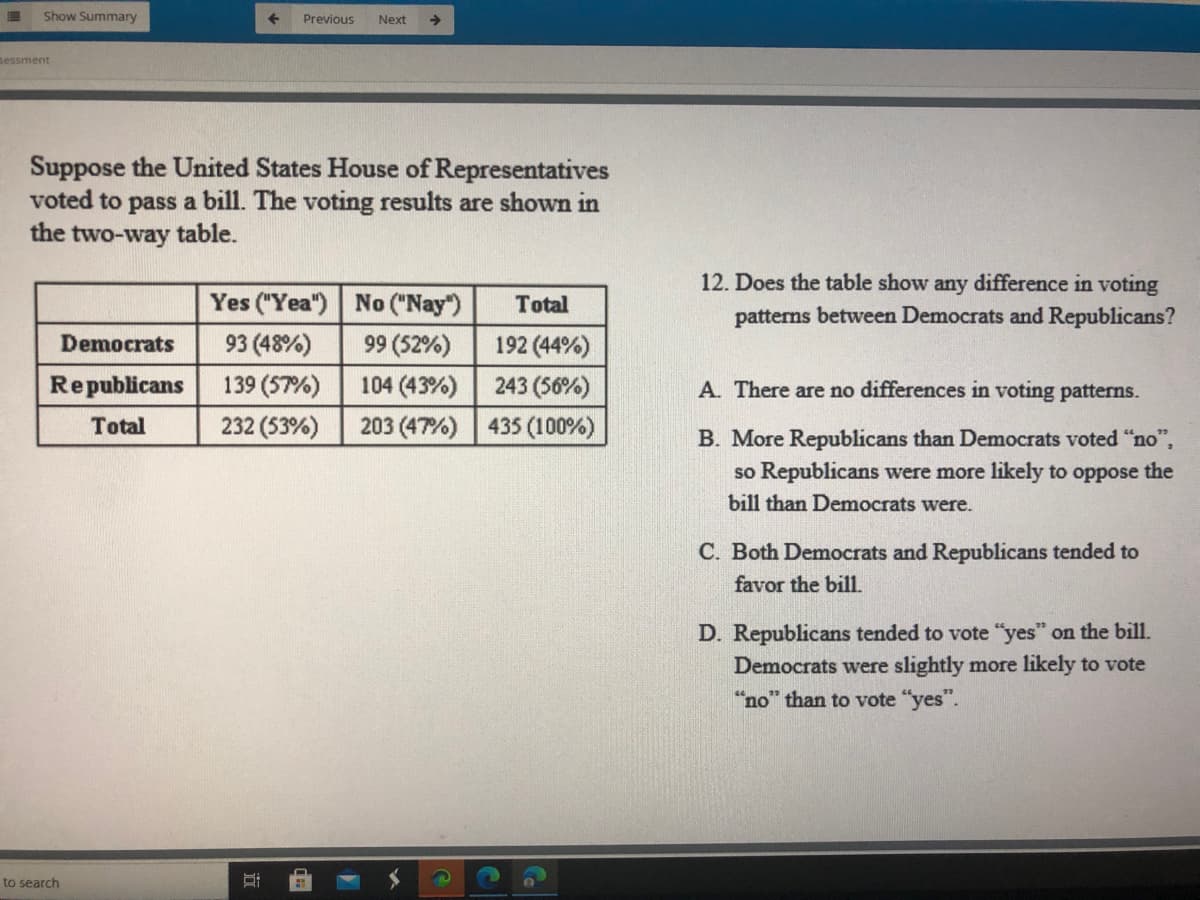Suppose the United States House of Representatives voted to pass a bill. The voting results are shown in the two-way table. 12. Does the table show any difference in voting Yes ("Yea") No ("Nay") Total patterns between Democrats and Republicans? Democrats 93 (48%) 99 (52%) 192 (44%) Republicans 139 (57%) 104 (43%) 243 (56%) A. There are no differences in voting patterns. Total 232 (53%) 203 (47%) 435 (100%) B. More Republicans than Democrats voted "no", so Republicans were more likely to oppose the bill than Democrats were. C. Both Democrats and Republicans tended to favor the bill. D. Republicans tended to vote "yes" on the bill. Democrats were slightly more likely to vote "no" than to vote "yes".
Suppose the United States House of Representatives voted to pass a bill. The voting results are shown in the two-way table. 12. Does the table show any difference in voting Yes ("Yea") No ("Nay") Total patterns between Democrats and Republicans? Democrats 93 (48%) 99 (52%) 192 (44%) Republicans 139 (57%) 104 (43%) 243 (56%) A. There are no differences in voting patterns. Total 232 (53%) 203 (47%) 435 (100%) B. More Republicans than Democrats voted "no", so Republicans were more likely to oppose the bill than Democrats were. C. Both Democrats and Republicans tended to favor the bill. D. Republicans tended to vote "yes" on the bill. Democrats were slightly more likely to vote "no" than to vote "yes".
Algebra and Trigonometry (6th Edition)
6th Edition
ISBN:9780134463216
Author:Robert F. Blitzer
Publisher:Robert F. Blitzer
ChapterP: Prerequisites: Fundamental Concepts Of Algebra
Section: Chapter Questions
Problem 1MCCP: In Exercises 1-25, simplify the given expression or perform the indicated operation (and simplify,...
Related questions
Topic Video
Question

Transcribed Image Text:Show Summary
Previous
Next
->
sessment
Suppose the United States House of Representatives
voted to pass a bill. The voting results are shown in
the two-way table.
12. Does the table show any difference in voting
Yes ("Yea") No ("Nay")
Total
patterns between Democrats and Republicans?
Democrats
93 (48%)
99 (52%)
192 (44%)
Republicans
139 (57%)
104 (43%)
243 (56%)
A. There are no differences in voting patterns.
Total
232 (53%)
203 (47%) 435 (100%)
B. More Republicans than Democrats voted "no",
so Republicans were more likely to oppose the
bill than Democrats were.
C. Both Democrats and Republicans tended to
favor the bill.
D. Republicans tended to vote "yes" on the bill.
Democrats were slightly more likely to vote
"no" than to vote "yes".
to search
|童
Expert Solution
This question has been solved!
Explore an expertly crafted, step-by-step solution for a thorough understanding of key concepts.
This is a popular solution!
Trending now
This is a popular solution!
Step by step
Solved in 2 steps with 1 images

Knowledge Booster
Learn more about
Need a deep-dive on the concept behind this application? Look no further. Learn more about this topic, algebra and related others by exploring similar questions and additional content below.Recommended textbooks for you

Algebra and Trigonometry (6th Edition)
Algebra
ISBN:
9780134463216
Author:
Robert F. Blitzer
Publisher:
PEARSON

Contemporary Abstract Algebra
Algebra
ISBN:
9781305657960
Author:
Joseph Gallian
Publisher:
Cengage Learning

Linear Algebra: A Modern Introduction
Algebra
ISBN:
9781285463247
Author:
David Poole
Publisher:
Cengage Learning

Algebra and Trigonometry (6th Edition)
Algebra
ISBN:
9780134463216
Author:
Robert F. Blitzer
Publisher:
PEARSON

Contemporary Abstract Algebra
Algebra
ISBN:
9781305657960
Author:
Joseph Gallian
Publisher:
Cengage Learning

Linear Algebra: A Modern Introduction
Algebra
ISBN:
9781285463247
Author:
David Poole
Publisher:
Cengage Learning

Algebra And Trigonometry (11th Edition)
Algebra
ISBN:
9780135163078
Author:
Michael Sullivan
Publisher:
PEARSON

Introduction to Linear Algebra, Fifth Edition
Algebra
ISBN:
9780980232776
Author:
Gilbert Strang
Publisher:
Wellesley-Cambridge Press

College Algebra (Collegiate Math)
Algebra
ISBN:
9780077836344
Author:
Julie Miller, Donna Gerken
Publisher:
McGraw-Hill Education